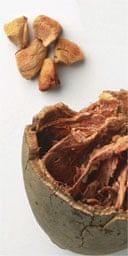Normally, as we all know from our close reading of tabloid headlines, the EU is too busy banning the old - bendy bananas, imperial weights from picturesque market stalls, etc - to have time to let in the new. However, after much lobbying by non-profit trade association PhytoTrade Africa, the EU this week announced that it had approved the fruit of the African baobab (or monkey bread) tree for use in the UK, thereby opening up a potentially lucrative market and creating employment for millions on the continent.
"It is a wonderful fruit!" rhapsodises Antonio Perez, who spent many years travelling around its native land before opening the African Kitchen Gallery Restaurant in central London. "It is very nutritious, full of vitamin C and vitamin A. It has a very special flavour, but the closest I can get to it is jackfruit, which is like melon."
But what can you do with it? Well, when it comes to the baobab fruit, it seems simpler to ask what can't you do with it. In Africa, it is used to alleviate various medical complaints, the leaves are eaten as a vegetable, and the seeds can be eaten raw or roasted, or ground to make an edible oil and thickener for soups and stews.
"For the fruit itself, you can peel it and slice it and cook it with anything - beef, chicken, even bake or grill it with fish," says Perez. "Roast it, mash it, puree it ..." Coming as it does from a culture with no tradition of writing down cookery methods, he says there is no master recipe. "They are learned from family to family, everybody will cook it differently. It will bring the flavour. You must bring your imagination."
You may need a smidgen more imagination than usual for now, as the EU has so far only approved the powdery pulp of the fruit for dismally denatured use in things like cereal bars and smoothies, but Perez remains undaunted. "It is like flour - you can blend it with anything," he urges. "You could make it into something like polenta, into porridge and have it for supper. It is a fantastic fruit."
·Should we be eating the baobob? Join the conversation on the food blog
